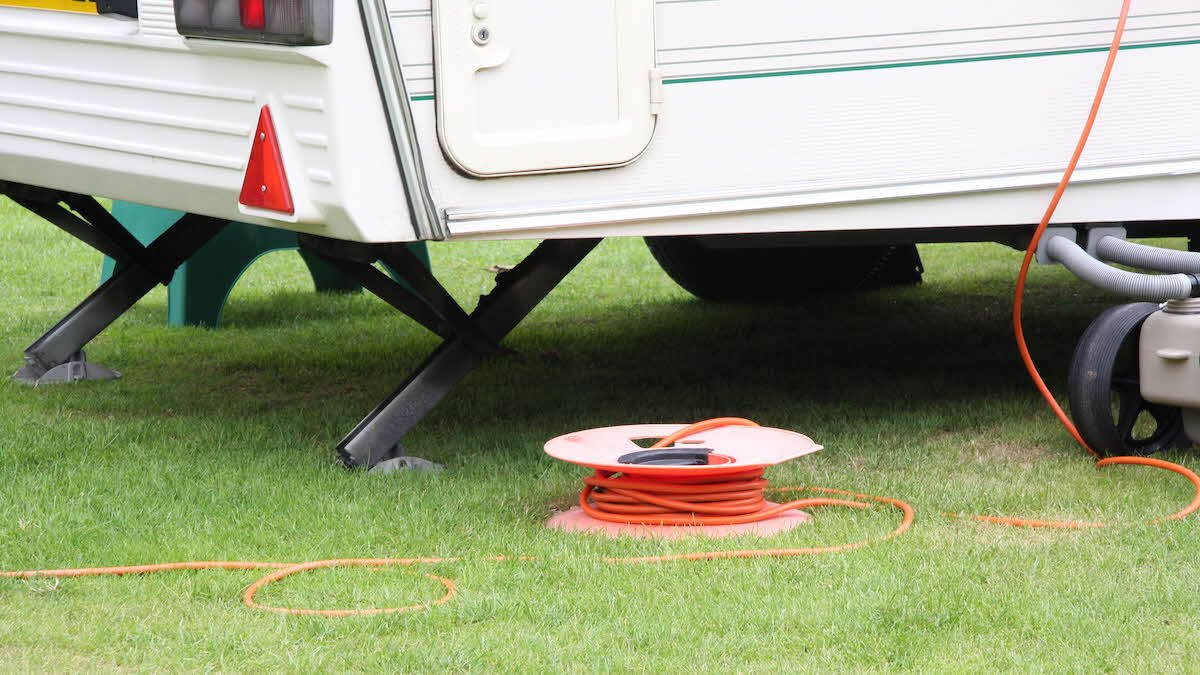Save at Club Shop
From solar panels to awnings, chairs to puncture repair kits, we've got what you need.
Find out moreIt’s important to pay proper attention to your unit’s – and the campsite’s – electrical systems. Our Health and Safety team explains…

Hook-up pillars
We take it for granted, but the vast majority of members make use of electricity while on campsites and CLs. Most of the time we enjoy our holidays without mishap, but it is important to remember that electricity can be very dangerous. This article, prepared by our Health and Safety department, shows the extents to which the Club goes to ensure your safety, and looks at fault scenarios and how to prevent them.
There are a number of on-site elements that could potentially cause problems.
For example:
Health and Safety law requires the Club to ensure that its electrical systems are designed, constructed, operated and maintained to prevent danger, so far as reasonably practicable.
In a touring environment, it’s possible that damage to cables, casings and connections may occur. For example, we have experience of bollards being damaged when units are driven away while still connected.
Please make sure you position cables with care, inspect them before use, remove them carefully and stow them safely before transport. Damaged cables or connections must be replaced or repaired by a competent electrician. Temporary repairs (eg with insulating tape or improvised junction boxes) should be avoided and are not permitted on Club sites as they present a genuine risk of contact with live parts, water ingress, shorting and breaks in earth continuity. Damaged or defective electrical connections can lead to ‘short circuits’ and ‘arcing’.
An ‘overload’ will occur if the power demand of an appliance(s) exceeds the rating of the supply. This causes overheating at the weakest point of the wiring, which may be concealed (eg within a unit’s structure and close to flammable insulation).
A ‘short circuit’ occurs where an electrical current flows through an unintended pathway of lower resistance (eg live and neutral wires are damaged and come into contact, bypassing the appliance). The result is an excess current.
‘Arcing’ is where electricity jumps across an intermittent connection or gap between conductors. This can generate temperatures of 30,000˚C.
All the above can potentially cause a fire. Symptoms include warm, melted or discoloured casings, plugs or cables and intermittent connections.
Bollards and touring vehicles are therefore fitted with Miniature Circuit Breakers (MCBs), designed to automatically trip out the circuit if a fault is detected. MCBs are a safety net and should never be used to facilitate overloading or the use of improvised wiring. Damage and overheating may occur before the MCB trips and after it is reset. Repeated tripping or fault symptoms must be investigated by an electrician.
 Coiled cable
Coiled cable
If a current is passed through an extension cable when it is coiled tightly, it will heat up. The reel and cable insulation contain plastics which can melt and ignite.
Therefore the Club requires that all live extension reels be unrolled tidily and fully before use. Never stow a live coiled cable under a unit which may contain sleeping occupants. When you leave your pitch temporarily, please disconnect your cable from the bollard and lay it tidily on the ground.

Uncoiled cable
The Wiring Regulations (and as a result, the Club) prohibit ‘splitters’ because they create the potential for overloading the supply.
Also, the performance of protective earthing can be affected if one branch feeds an appliance in a caravan and the other appliances in an awning.

Daisy chain
The Club also prohibits the use of multiple cables ‘daisy chained’ together with connectors. This is because connectors may not be suitably rated to prevent water ingress if left on wet ground or in a puddle and the Wiring Regulations require a single length of cable between the unit and bollard.
All non-essential appliances must be switched off when a unit is unattended. A particular risk arises from heaters fitted with a thermostat unless they are designed to be left on.
 Hooking up to a bollard
Hooking up to a bollard
A recent change in the Wiring Regulations required the installation of an ‘interlock’ to prevent plug insertion and extraction when the socket is live. This is to control the risk of arcing and of accidental contact with live conductors. Therefore, the MCB on a new bollard will trip every time a cable is unplugged. All new installations must be of the new type. To reset simply look round the bollard to find the offending MCB and reset it after the cable is plugged in securely.
Vehicle modifications and conversions must be undertaken by a competent person. This means an electrician qualified to the current (18th) edition of the Wiring Regulations with experience in 12V and 230V systems, however simple the job appears to be.
DIY modifications or conversions of units or equipment, particularly involving mains voltage, may affect user safety, insurance and warranty cover.
The Club has an extensive, compliant programme of testing and condition surveys to ensure our electrical systems are safe. This includes regular inspection by staff as well as periodic competent inspections on all electrical systems on our sites. If you spot any problem with our site electrical systems, please inform the site manager as soon as possible.
We hope you have found the above information useful. Electrical issues are rare in modern touring vehicles and on site – but it’s important to remain vigilant.